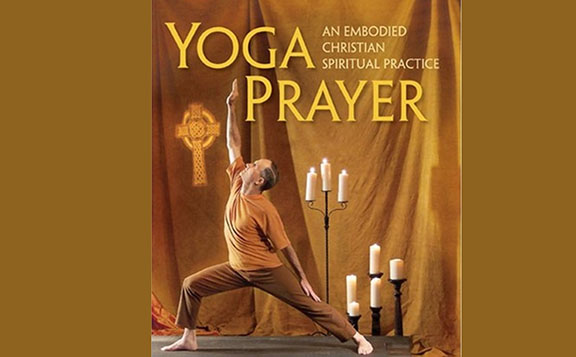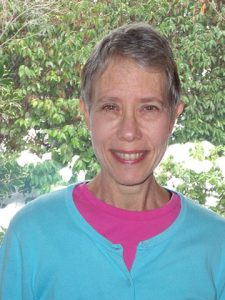 Can Yoga be practiced from a Christian perspective? Amy Russell explains how a group of people—writers and teachers, pastors and soccer moms, musicians and artists, medical doctors and community activists came together as “Christians practicing Yoga.” They were encouraged by Father Tom Ryan, CSP, a Catholic priest who embarked on his own study of Yoga many years ago. Fr. Tom’s book, Prayer of Heart and Body: Meditation and Yoga as Christian Spiritual Practice and his DVD, Yoga Prayer: An Embodied Christian Spiritual Practice, demonstrate how he utilizes Yoga postures as a way of praying through the body. Further inspired by their individual and collective experience that Yoga and meditation deepened their Christian faith, they created a website (christianspracticingyoga.com) to share how they practice in ways consistent with the logic of their own faith.
Can Yoga be practiced from a Christian perspective? Amy Russell explains how a group of people—writers and teachers, pastors and soccer moms, musicians and artists, medical doctors and community activists came together as “Christians practicing Yoga.” They were encouraged by Father Tom Ryan, CSP, a Catholic priest who embarked on his own study of Yoga many years ago. Fr. Tom’s book, Prayer of Heart and Body: Meditation and Yoga as Christian Spiritual Practice and his DVD, Yoga Prayer: An Embodied Christian Spiritual Practice, demonstrate how he utilizes Yoga postures as a way of praying through the body. Further inspired by their individual and collective experience that Yoga and meditation deepened their Christian faith, they created a website (christianspracticingyoga.com) to share how they practice in ways consistent with the logic of their own faith.
From its ancient beginnings, Yoga was a rigorous spiritual discipline that demanded strict adherence to an ethical code of life as well as intense physical practices. It was understood that how we think, behave and move are deeply interrelated, and that to know God we must gain control over our mental and physical impulses. Yoga developed in India, a primarily Hindu culture, but was intended as a universal human practice. As “Christians practicing Yoga” we approach Yoga with a deep sense of gratitude and respect for its ancient history. Our intention is not to “Christianize” Yoga. Rather, we share a strong desire to live a holistic Christian spirituality and to benefit from practices that contribute to it.
Yoga, understood not just as Hatha Yoga, is about experiencing our capacity for union with the divine and experiencing this reality in our very beings. As Fr. Tom writes: “The human person is not a soul and a body, but inspirited flesh, an animated body. One is one’s body and is one’s soul at one and the same time.” Yoga is not about becoming someone else, but rather becoming more of who we are: creatures made by God to give and receive love. As we practice, we discover that Yoga is not something we merely do. Rather, Yoga is a way of being with our selves, with one another and with the world. Through Yoga we claim our embodiment, our flesh, as God’s own, given as pure gift.
As Christians, we hear the cries of the human heart echo through the Psalms—the agony of suffering, loss, betrayal, defeat; the joys of love known and shared. We touch this place of compassion that is shared by practitioners of all religions. We recognize our deep connection with the entire human family, held together through the sacredness of our human bodies. We share the embodied condition with all people, regardless of culture, religion and history. We share the longing of the human heart that thrives on love and is beaten down by violence, abuse and neglect. As “Christians practicing Yoga,” we practice to expand our capacity to love. We learn to bring compassion to one another and ourselves. Our practice includes four basic and traditional disciplines: study, devotion, selfless acts and meditation. These are described below.
We study Holy Scripture, individually and in groups. We may read books about Christian theology and spiritual practice. We may be drawn to study the sacred writings of other faith traditions. We may take classes to learn more about Yoga tradition, philosophy and discipline and to strengthen our practice. The purpose of our study is to consciously and willingly participate in God’s transformation of us (Romans 12:2).
Most of all, our study takes the form of practice, “on the mat” and “off the mat.” Much of what we practice are Yoga postures. Each posture opens the body in a particular way; each posture serves as a small window into who we are. Practice reveals our habits of body and mind, and we come to know our strengths, weaknesses and limitations. While holding postures and moving from one posture to another, we observe our bodies, following the changing patterns of sensations moving through joints, muscles and bones. We study our minds, our thought patterns that arise in response to the pose, and learn to recognize the deeply ingrained patterns of mind affecting body and of body affecting mind. As Fr. Tom explains in his book, Reclaiming the Body in Christian Spirituality: “The result (of practice) is an experience of equilibrium, peace and interior harmony. Stretching and lengthening muscles that are chronically contracted helps to rebalance both body and mind . . . This holistic union of body and mind provides the climate, the ‘environment,’ for a spiritual, intuitive experience of God.” Through this process we are transformed from the inside out, as we learn to cultivate non-judgmental, discerning awareness.
Our Yoga practice is fueled by our faith in Jesus Christ. The opening words of St. John’s Gospel are, “In the beginning was the Word, and the Word was with God and the Word was God.” As Christians, we understand this word in terms of incarnation, God taking the form of Jesus Christ. Fr. Tom writes in his book, Prayer of Heart and Body: “The doctrine of the Incarnation stands at the center of Christian faith and is the bedrock for our understanding of the major truths of Christianity: the Trinity, the church, the sacraments, grace and life after death. In broad terms the Incarnation is the doctrine about Jesus of Nazareth as the eternal Word of God become flesh (John 1:14). The Word became a human being and lived here with us. We saw his true glory, the glory of the only Son of the Father. From him all the kindness and all the truth of God have come down to us. The second person of the Trinity comes down from heaven and enters fully into the human condition in the life and death of Jesus.”
For us “Christians practicing Yoga” our devotional practice centers in allowing this reality to become flesh in our own lives; allowing the reality of Jesus—human and divine—with all the individual and cosmic significance this implies to penetrate our bodies, minds and spirits. Like Christians everywhere, devotional practice involves prayer and regular attendance at worship. Devotion means regularly surrendering the fruits of our practice to God. We often approach our Yoga practice as a form of prayer. We may do this by offering a surrendering prayer at the beginning of practice. Or we may dedicate our practice for the benefit of someone or a group that we are concerned about. “Off the mat” our Yoga way of being includes being mindful of how we behave toward one another and ourselves. As we practice these Yoga principles, we do so with the conscious intention of drawing closer to Christ.
Jesus tells us that the greatest commandment is “Love the Lord Your God with all your heart and with all your soul and with all your mind . . .” and the second commandment is “Love your neighbor as yourself.” (Matthew 23:37-38) In Yoga we learn how deeply these two commands penetrate each other. As Christians, we look out upon the suffering world, suffering in our communities, in our families, in ourselves and we hear Christ’s call to act, to reach out our hand in love. Paradoxically we grow in our capacity to give to others by becoming more fully who we already are: creatures of God made in and for love.
Our practice “on the mat” fuels us, energizes and renews us, for selfless acts of service “off the mat.” Our giving may be small, like giving up a seat on the bus to someone in need, or it may be a larger act of service like helping to build new homes for the poor. What matters is not the size of the act but our giving in itself, and our willingness to help where we can.
Like Christians throughout the centuries, we struggle at times individually and as a community to find the balance between prayer and action, between practice “on the mat” and “off the mat.” Sometimes Yoga practitioners are rightly criticized for being too inwardly focused. As Fr. Tom advises us: “The tensions between self-realization and participation in common life, between contemplation and action, are healthy and creative, even if not always comfortable. We simply need to find the balance.”
Christianity, like all religions, has a rich tradition of meditation practice. While the methods differ, the essence of meditation is to help still the mind and to bring the practitioner into deeper contact with what is Real. There are basically two streams of meditation practice: narrowing down the field of awareness to an object of mental focus (concentrative practice) and opening wide the field of awareness to whatever is happening in the body/mind (awareness practice). In concentrative practice in the Christian tradition, the object of focus is most often a sacred word or phrase to anchor the mind. As thoughts arise, the practitioner lets them go and returns to the word or phrase. Christian teachers such as John Main and Thomas Keating have adapted this ancient practice for modern life and have brought Christian meditation into the mainstream.
Awareness practice comes from Buddhism and opens out to become fully aware of thoughts, feelings and sensations as they arise. Here, the mind is anchored on the breath, returning to the constant flow of inhale and exhale as awareness expands. There are Christians such as Mary Jo Meadow (of Resources in Ecumenical Spirituality) who work also with this method in the light of the teachings of John of the Cross and Teresa of Avila.
As Tilden Edwards says, “What makes a particular practice Christian is not its source, but its intent. If our intent in assuming a particular bodily practice is to deepen our awareness in Christ, then it is Christian. If this is not our intent, then even the reading of Scripture loses its authenticity.” Both these methods cultivate an inner environment that attunes us to God’s loving presence.
 About the Author
About the Author
Amy Russell studied Yoga for several years at the Iyengar Institute in New York City, completed a certificate in energy healing at the Brennan School in 1996, and completed Yoga teacher training with Todd Norian (Kripalu/Anusara) in 2002. She assisted Father Tom Ryan for several years with the weekly Prayer of Heart and Body class in New York City.
In 2012, Amy moved with her husband, Bret, to White Salmon, Washington, where she regularly teaches at Yoga Samadhi. They have two grown sons, Matthew Kaijo and Mark. Amy holds a master’s degree in Anglican Theology from General Theological Seminary and writes regularly about embodiment, faith, and the integration of body into spiritual practice. Find her writing on her blog, Incarnation Place.
For more information, please visit: www.christianspracticingyoga.com. For further information about Father Tom Ryan, his books, DVD, retreats and workshops, please visit: www.tomryancsp.org.

